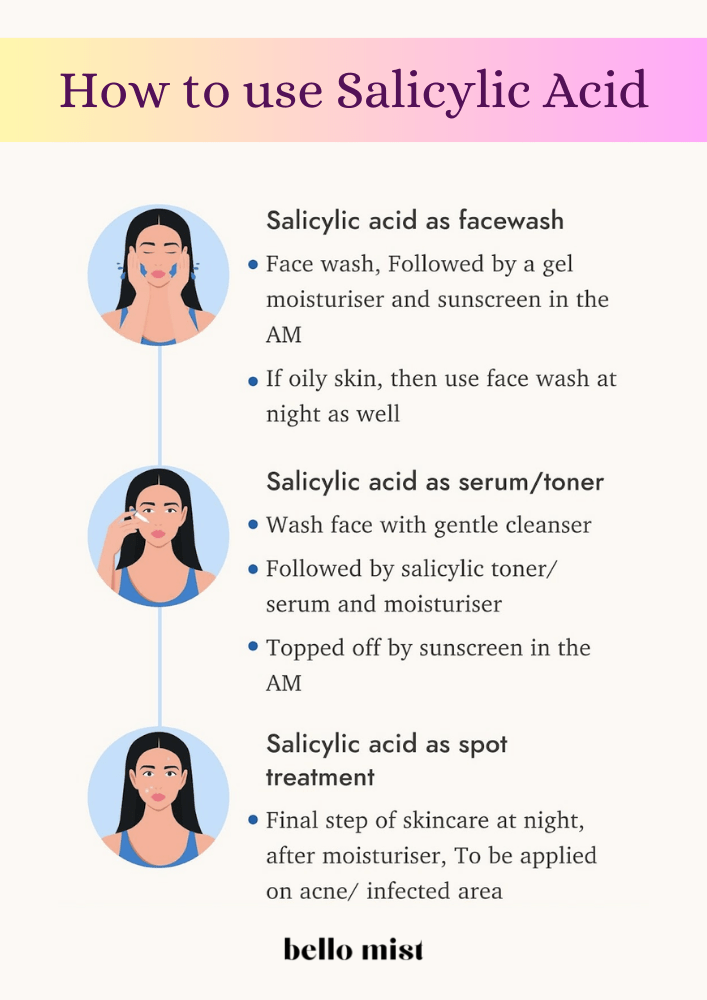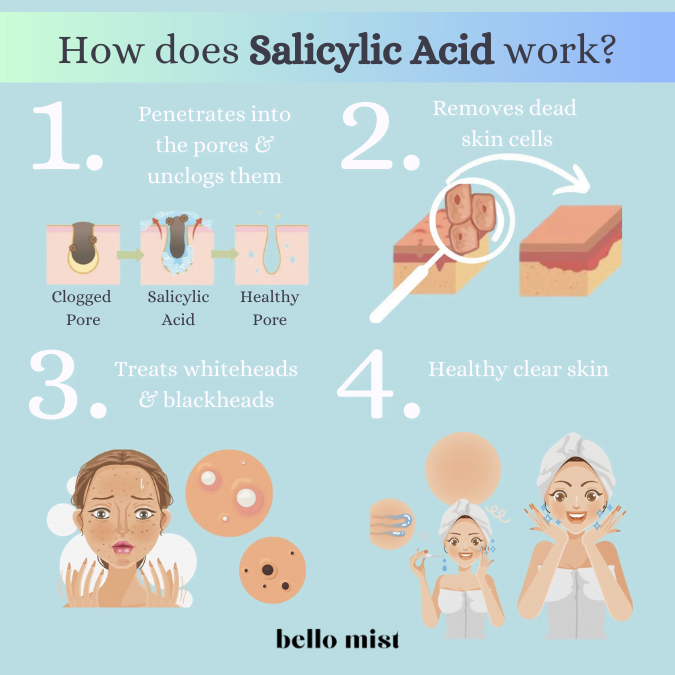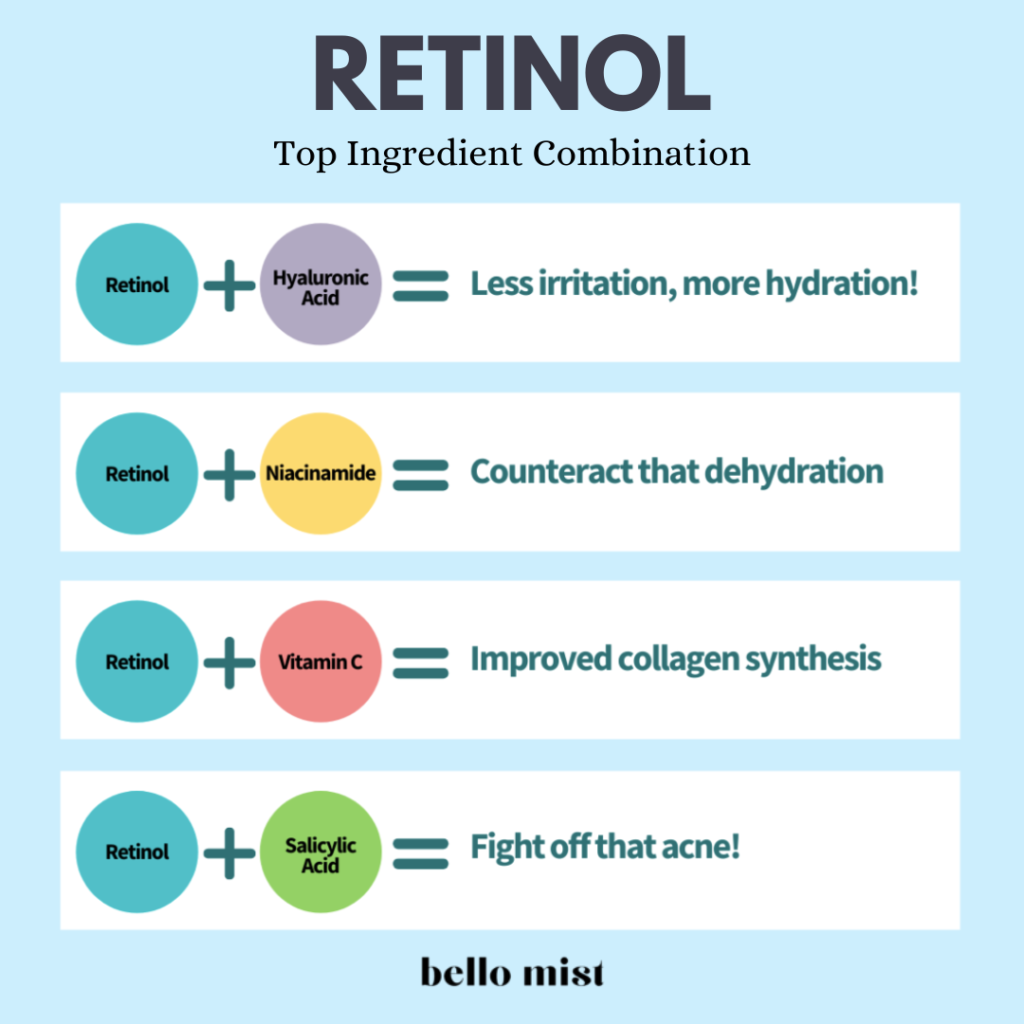Are you passionate about taking care of your skin? Do you like using classic skincare items or just beginning to establish a skin care regimen? Then you may be wondering about how to include Salicylic acid and retinol in your skincare regimen.
It’s essential to understand when and how to combine salicylic acid and retinol if you’re looking for a skincare regimen that addresses your individual needs. These two popular components are acclaimed for their ability to combat acne.
But, many people are still determining whether their combination will be beneficial or lead to irritation.
All skin health experts agree that a BHA like salicylic acid and retinol can be safely used together, but only if applied correctly.
This article will explain the basics of these two popular ingredients and how they can work together to give you the best results.
What does Salicylic Acid do for the skin?

Salicylic Acid, also known as BHA, is derived from the bark of a willow tree but is usually created synthetically in a laboratory.
Putting it on your skin helps break down the bonds between dead cells, making it much easier to remove and reducing the risk of them accumulating.
This exfoliating action is very beneficial since most acne is caused by pores that become blocked with dead skin and other impurities, which traps bacteria.
By reducing the number of dead skin cells on the surface, your complexion will appear brighter, more glowing, and even.
Salicylic Acid is a popular and practical choice for combination and oily skin types, as it can reduce the appearance of sun damage, acne, and redness. This powerful Acid is soluble in oil, which helps facilitate its penetration into the pores.
By traveling with the skin’s natural oils, salicylic Acid can work from the inside out to exfoliate and soothe irritated skin. As a bonus, it has anti-inflammatory properties that can reduce inflammation.
Shop Salicylic Acid Now

The benefits of Salicylic acid
Salicylic acid boasts several advantages, especially for those prone to breakouts. These benefits may include the following:
- Clearing up the skin and stopping future breakouts
- Reducing the number of whiteheads and blackheads
- Exfoliating the skin
- Smoothing the face
- Kills germs and bacteria
- Opening clogged pores
- Decreasing excess oil
- Calms irritation and visible redness

Salicylic acid products are mostly obtainable over the counter.
What does Retinol do for the skin?
Retinol is a popular skincare product that many people use to combat the signs of aging. Despite its recognition, many need to know what retinol is and where it comes from.
It is a form of vitamin A, an essential nutrient for the body to function. In addition to its internal benefits, it can be beneficial when used topically.
The most impressive effect of retinol is its ability to speed up the natural skin cell renewal process, which usually happens every 30 days.
It means that fresh, new skin cells will be revealed, which can help to even out the complexion, soften wrinkles and fine lines, reduce dark spots, and improve the skin’s overall texture.
Retinol is an excellent skin care option, but you should use it in the right concentration. Those with delicate and fair skin types may feel discomfort when they first start using it, so it’s best to patch-test it before applying it.
Watch out for any signs of irritation, such as redness or peeling. If you experience symptoms of irritation, reduce the amount of retinol you use. If you don’t experience any symptoms, feel free to apply it at night and wake up with visibly smoother and firmer skin.
Shop Retinol Now.
The benefits of Retinol
Like salicylic acid, retinol presents its targeted advantages for the skin.
- Decreases the formation of wrinkles and fine lines
- Clear pores and minimize their formation
- Brighten the complexion
- Smooth the complexion
- Even out the skin tone
- Works to retexturize and resurface your skin
While some retinol products are obtainable over the counter, other, more potent forms of the element require a prescription and a visit to a dermatologist.
Should you use both Salicylic acid and Retinol?
Salicylic acid and retinol may be worth considering if you have acne and wrinkles. You will still see improvements if you opt for just one of them. However, to maximize the benefits, it is best to combine the two.
Both are known for their effectiveness; salicylic acid for combatting acne and retinol for diminishing signs of aging.
If you only use retinol, you may not obtain optimal acne-clearing results, and if you only use salicylic acid, you will not be able to fight wrinkles effectively. But with both, you will have the best of both worlds.
Moreover, you can quicken your results since salicylic acid and retinol can address the same issues, such as shedding skin cells, clogged pores, discoloration, and irritation, albeit through separate pathways.
Thus, you can approach the problem from two angles for faster, more effective results.

Can you use Salicylic acid with Retinol?
Many people have more than one skin concern, which can be challenging to address with the right ingredients. If you’re experiencing signs of aging and breakouts, using salicylic acid and retinol may be tempting. Dermatologists highly regard both for treating their respective issues.
Can we use them together? The answer is yes, just be aware of the potential for dryness.
Individually, each ingredient can cause dryness, so combining them increases the chances of that happening. Even with this in mind, you can still benefit from both advantages.
If you want to save your skin from dehydration, it’s wise to alternate using salicylic acid and retinol in your skincare regimen. Thus, use the salicylic acid product in the morning and the retinol product in the evening. It’s also essential to enlist a quality moisturizer in your routine.
As your skin adjusts to both ingredients, you may experience some harm to your moisture barrier. Using moisturizer and drinking lots of water can preemptively avoid any undesired issues.

Can you mix Retinol with other hydroxy acids?
When using other Hydroxy Acids in addition to Retinol, keep in mind the same guidelines. For best results, you should avoid combining them during a single session, as this might be too much for your skin to handle.
Glycolic Acid is the strongest of the Hydroxy Acids, so blending it with Retinol is not usually recommended. It’s best to alternate days, mornings, and evenings when using the two together.
Everyone’s skin has different tolerance levels, so it’s essential to listen to your skin and devise a routine that works for you. Consulting with a professional skin therapist can help you decide when to use your active ingredients.
How to use Salicylic acid and Retinol together?
If you’re using two powerful acne-fighting ingredients, you should be careful when you put them together. It is safe to add salicylic acid and Retinol to your skincare routine, and it can be pretty effective, but too much of them can make your skin dry.
Although we do not suggest applying them simultaneously, you can still include salicylic acid and Retinol in the same skincare routine. Here’s how you can do it:
1. Use Salicylic Acid in Morning and Retinol at Night
Incorporate salicylic acid and Retinol into your daily routine by using them at different times.
Most dermatologists suggest using Retinol exclusively at night as it can make your skin more susceptible to sunlight and reduce the product’s effectiveness.
For the morning, salicylic acid is ideal. It is worth noting that salicylic acid does not have photosensitizing properties and even offers some degree of photoprotection.
However, using sunscreen during the day is still essential.
2. Use Salicylic Acid and Retinol on Alternate Nights
It is best to alternate between Salicylic Acid and Retinol when applying them to your skin at night. Start by cleansing your face and then use the Salicylic Acid. On the following night, apply the Retinol.
You could also adjust the frequency to match your skin’s needs and desired results. Here are a few examples of what this could look like:
- Using Salicylic Acid and Retinol on alternating nights
- Applying Salicylic Acid for two nights, followed by Retinol on the third night
- Applying Retinol for two nights and Salicylic Acid on the third
- Using Salicylic Acid for one night, taking a break on the second night, applying Retinol on the third night, and then resting again on the fourth night.
If your skin is sensitive or you are starting out using more robust products, it is best to take it slow. Begin with a lower dose and slowly increase the concentration and frequency.
3. Use Salicylic Acid and Retinol 30 Minutes Apart
If you want to utilize salicylic acid and Retinol simultaneously, you can, but you must wait between applications. Begin with the most acidic product, which is the salicylic acid, and apply it as directed.
Afterward, please wait for 30 minutes so salicylic acid can work to its ideal pH level, which is somewhere between 3.0 to 4.0, allowing it to penetrate the skin.
Once the time has passed, apply your Retinol since the skin’s pH should have returned to its usual, more neutral value. This makes it easier for Retinol to convert.
However, we only suggest this if your skin is familiar with salicylic acid and Retinol, which could irritate.
The goal of the waiting period is to ensure that each ingredient works at its fullest potential without reducing absorption or conversion.

Wrapping Up
Is it possible to use salicylic acid and retinol together? Yes, it is possible, but you must keep your skin hydrated and avoid irritation.
Both salicylic acid and retinol have impressive results when used separately; however, their combination can be even more effective in clearing up your skin, giving it a younger and smoother look.
To fetch the best out of these two components, apply salicylic acid and retinol at different times of the day, alternating nights, or with a gap of 30 minutes between each one. This way, they will remain at their optimal pH level, ensuring the best results.
Read More
How to use CeraVe skincare products for maximum benefits.
Is CeraVe good for oily skin? An in-depth review.
Is Cetaphil good for acne? Complete & Honest Review.
CeraVe or Cetaphil: Which is better? [2023]
